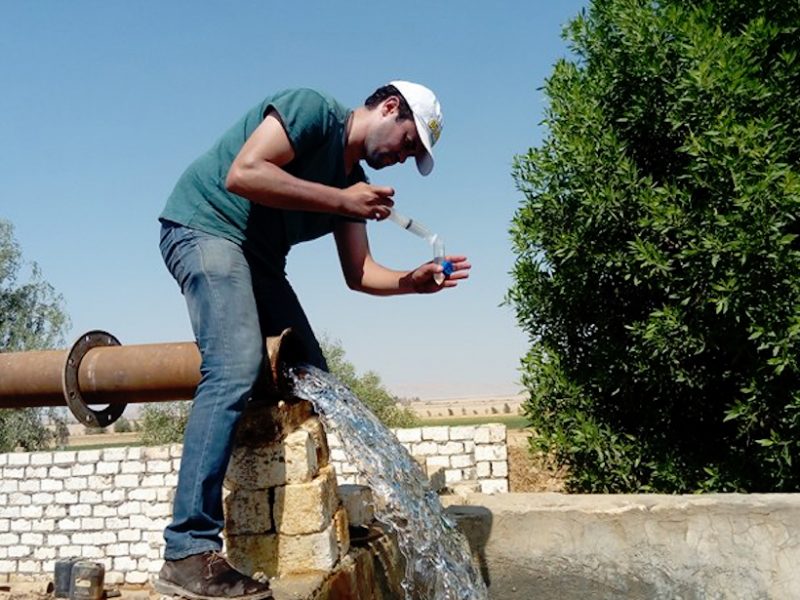https://eos.org/articles/ancient-water-underlies-arid-egypt
Ancient Water Underlies Arid Egypt
A hidden trove of groundwater is left over from the last ice age.

Many Egyptian wells are located in oases, where groundwater is close to the surface, creating a lush green habitat surrounded by desert. Credit: Mahmoud Sherif
Aside from the Nile River's green corridor, much of northeastern Africa is desert. But the arid landscape hides a secret: Vast quantities of groundwater fill an underground aquifer that spans four countries.
A new study using chloride isotopes to date the groundwater under Egypt's Eastern Desert has found that the water in smaller, shallower aquifers is refilled by the larger, deeper aquifer, where vast quantities of groundwater date to the last ice age.Most Egyptians live along the Nile and get their drinking and irrigation water from the river. Currently, just 7% of the country's water usage is supplied by groundwater, but that number is expected to rise, said Mahmoud Sherif, a hydrogeochemist at the University of Delaware and lead author of the new study, published in Earth and Planetary Science Letters. "In the future, as Egypt's population and agriculture expand, groundwater will become a more important resource."
The research team set out to date the age of the groundwater under the Eastern Desert to determine the aquifers' responses to climate conditions and the recharge rates of shallower formations called alluvial aquifers. "These aquifers are closer to the surface and easier to access than the deeper Nubian aquifer," Sherif told Eos.
"We expected the water in the shallow aquifers to be less than 100 years old," Sherif said, with the clock starting when the rainwater falls from the atmosphere onto Earth. Instead, some of the water samples were more than a thousand times that age.

The researchers used the radioactive isotope chlorine-36, which has a half-life of 300,000 years, to date groundwater samples collected from 29 wells scattered around the Eastern Desert. They found that the oldest samples in the alluvial aquifers were more than 200,000 years old. "This was really surprising," Sherif said.
Mixing with the Nubian aquifer helps explain the age: "This region is tectonically active and has a lot of deep-seated faults. Groundwater from the Nubian aquifer is making its way up along these faults and recharging the alluvial aquifers," Sherif said.
The Nubian Sandstone Aquifer System is the largest known fossil water aquifer in the world. Spanning more than 2 million square kilometers across Sudan, Chad, Libya, and Egypt, it contains more than 150,000 cubic kilometers of groundwater—more water than the Nile River discharges in 500 years.
The water in the Nubian aquifer dates back to the Pleistocene epoch, when Earth weathered periodic deep freezes.
"During the Ice Age, what is now desert was a lot greener and wetter," said Cliff Voss, a hydrogeologist with the U.S. Geological Survey in Menlo Park, Calif., who was not involved in the new study. Today, the Nubian aquifer may receive a little water during flash flood season, but the recharge rate is "effectively zero," Voss said.
The new study offers new data on the little-studied Eastern Desert, and the findings match up well with previous studies of the Western Desert and the rest of the region underlain by the Nubian aquifer, said Voss.
"In 2014, we mapped out the Nubian aquifer in the hopes that the four countries wouldn't have to compete over their share of the water," Voss said of his 2014 study published in the Hydrogeology Journal. "Fortunately, all four countries essentially have water forever, especially Egypt and Libya."
To date, Libya is the only country to tap into the vast water reserves of the Nubian aquifer on a large scale. The pipelines known as the Great Man-Made River carry water from 1,300 wells more than 2,800 kilometers inland across the desert to the coastal cities of Tripoli, Benghazi, and Sirte.
The connection between the alluvial aquifers and the Nubian aquifer means that communities and agricultural operations in the Eastern Desert have an almost unlimited supply of groundwater without having to drill very deep.
"It's a gorgeous supply of water, clean, not salty," Voss says. "You can drink it without any filtration or treatment."
—Mary Caperton Morton (@theblondecoyote), Science Writer
-- Sent from my Linux system.
No comments:
Post a Comment